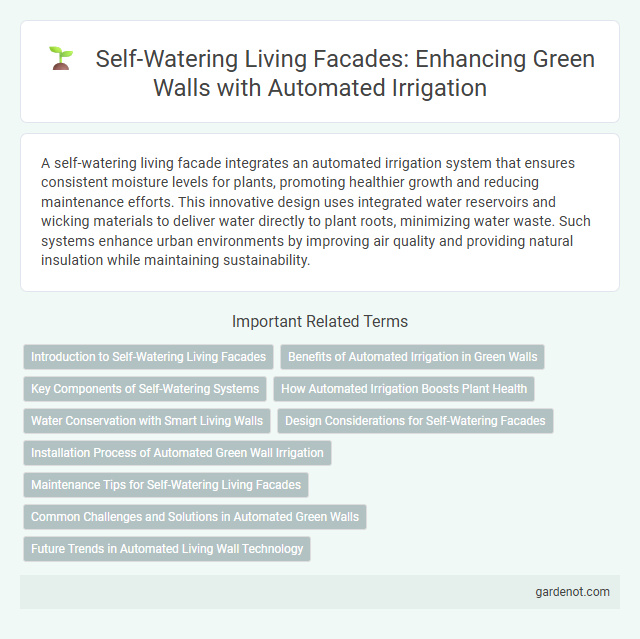A self-watering living facade integrates an automated irrigation system that ensures consistent moisture levels for plants, promoting healthier growth and reducing maintenance efforts. This innovative design uses integrated water reservoirs and wicking materials to deliver water directly to plant roots, minimizing water waste. Such systems enhance urban environments by improving air quality and providing natural insulation while maintaining sustainability.
Introduction to Self-Watering Living Facades
Self-watering living facades integrate advanced irrigation systems within vertical gardens to maintain optimal moisture levels for plant growth without manual watering. These facades use capillary action, drip irrigation, or hydroponic techniques to ensure efficient water distribution, promoting healthy vegetation and reducing water waste. By combining sustainable architecture with smart water management, self-watering living facades enhance building insulation and urban biodiversity.
Benefits of Automated Irrigation in Green Walls
Self-watering living facades utilize automated irrigation systems that optimize water usage by delivering precise moisture levels directly to plant roots, enhancing plant health and growth. These systems reduce water waste and maintenance costs while ensuring consistent hydration, especially crucial in urban environments with fluctuating weather conditions. Integration of sensors and timers allows real-time monitoring and adjustment, promoting sustainability and increasing the longevity of green wall installations.
Key Components of Self-Watering Systems
Self-watering living facades rely on essential components such as integrated drip irrigation systems, moisture sensors, and water reservoirs to maintain consistent hydration for plants. Automated valves regulate water flow based on sensor feedback, optimizing water use efficiency and reducing runoff. High-quality substrates with moisture retention properties also play a vital role in supporting healthy root systems and sustaining plant life on the vertical surface.
How Automated Irrigation Boosts Plant Health
Automated irrigation in self-watering living facades ensures precise water delivery tailored to each plant's needs, significantly reducing water stress and promoting optimal growth. Sensors monitor soil moisture and environmental conditions, allowing real-time adjustments that prevent overwatering and root rot. This technology enhances plant health by maintaining consistent hydration, improving nutrient uptake, and increasing the lifespan and vibrancy of vertical greenery systems.
Water Conservation with Smart Living Walls
Self-watering living facades integrate advanced irrigation systems that recycle water to minimize waste and promote efficient hydration for plants. These smart living walls utilize sensors and automated controls to regulate moisture levels, ensuring optimal water use and enhancing sustainability. By conserving water through precision delivery, self-watering facades contribute significantly to urban eco-friendly architecture and green building standards.
Design Considerations for Self-Watering Facades
Design considerations for self-watering living facades include selecting appropriate plant species with varying water requirements and root structures to maximize system efficiency. Integration of automated irrigation technology, such as moisture sensors and drip irrigation, ensures precise water delivery while minimizing waste. Structural support must account for weight distribution and access for maintenance, optimizing both plant health and facade durability.
Installation Process of Automated Green Wall Irrigation
The installation process of an automated green wall irrigation system begins with securing a durable frame and mounting a waterproof membrane to protect the building facade. Integrated drip irrigation lines and moisture sensors are then installed within the growing medium to ensure precise water distribution and conservation. Finally, the system is connected to a programmable controller that adjusts watering schedules based on real-time environmental data, optimizing plant health and minimizing water usage.
Maintenance Tips for Self-Watering Living Facades
Self-watering living facades require regular inspection of their irrigation systems to prevent clogging and ensure consistent moisture delivery to the plants. Monitoring water levels and adjusting the system seasonally helps promote healthy growth and reduce water waste. Regular pruning and fertilization tailored to plant species maintain the facade's aesthetic appeal and structural integrity.
Common Challenges and Solutions in Automated Green Walls
Self-watering living facades often face challenges such as uneven water distribution, root system overcrowding, and algae buildup, which can compromise plant health and system efficiency. Implementing precision irrigation technologies and modular planting units improves water delivery accuracy and root space management, reducing maintenance needs. Regular monitoring and integrating biofilm-resistant materials minimize algae growth, ensuring sustainable automated green wall performance.
Future Trends in Automated Living Wall Technology
Self-watering living facades are advancing with automated irrigation systems that use sensors to monitor soil moisture, temperature, and light levels, ensuring optimal plant health and water efficiency. Future trends include AI-driven analytics predicting maintenance needs and adaptive watering schedules, reducing resource consumption and enhancing sustainability. Integration with smart building management systems allows seamless control and real-time data visualization, revolutionizing urban green infrastructure.
Self-watering living facade Infographic

 gardenot.com
gardenot.com